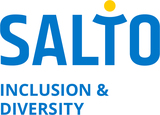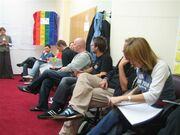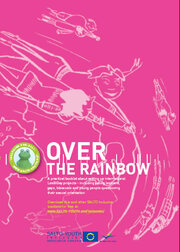Funding for LesBiGay youth projects
- Find this and more in the SALTO Inclusion for All booklet: Over the Rainbow
Where to get money from?
There exist a great number of sources of funding for yout or LGBT activities, as well as for LGBT youth in particular.
In General:
- The bigger the provider, the more funding, the stricter the rules and procedures, the more paperwork, the more formal procedures
- The smaller the provider, the smaller the contribution, the more creative the ways of getting the money (e.g. fundraising ideas), the more reliance on personal contacts and understanding
Who gives money?
International Organisations
- Unesco, United Nations: www.unesco.org
- Council of Europe: European Youth Foundation, European Mobility Fund (rail travel) www.coe.int/youth/
- European Union: e.g. Youth in Action programme (see below)http://ec.europa.eu/youth/, EQUAL, Combat against Discrimination, etc. more info on European funding from www.eurodesk.org
International Co-operation Agreements
- Commonwealth Youth: www.thecommonwealth.org/cyp, www.cyec.org.uk,...
- Francophone Countries Youth Mobility: http://pmj.francophonie.org/
National Ministries and Governments
- Cross-border co-operation: e.g. French-German Youth Office www.ofaj.org, German Czech Youth Office, Romanian-Hungarian Youth Co-operation, etc.
- National Projects: e.g. Dutch Government funding for LGBT projects in Eastern Europe www.movisie.nl, etc.
- Embassies or Cultural Institutes of other countries: e.g. www.britishcouncil.org, www.alliancefr.org, www.goethe.de, Swedish Embassy, etc.
Foundations and Funders
- Find a list of general Foundations in the www.fundersonline.org database of the European Foundation Centre www.efc.be
- Find a list of LGBT specific Foundations at www.lgbtfunders.org & www.iglhrc.org
- ILGA Europe also has a list of LGBT funders www.ilga-europe.org
National LGBT Organisations with an international focus
- COC Netherlands: www.coc.nl
- RFSL Sweden: www.rfsl.se and www.rfslungdom.se
- LBL Denmark: www.lbl.dk
Companies
- Sponsorship
- Contributions in kind
Local Community
- Local Authorities, City youth council, etc.
- Political parties
- Local Charities
- Churches
- Trade Unions
Individuals
- Fundraising, cake sales, raffles, etc.
- Check the fundraising idea-bank at www.fund-raising.com/fundraising-ideas.php
- Participation fees
Some Remarks:
- Always check with your country's tax office whether funding is considered 'income' or 'revenue' for your organisation, which could mean that you might have to pay taxes on it
- Virtually none of the funding providers will allow 100% funding - most require co-funding or your own contribution - where are you going to get co-funding from?
- Make sure that your project is adapted to or fits the aims and procedures of the funding providers - have a plan B in case a funding application isn't granted
^^ top ^^
The European Union's Youth in Action programme
The Youth in Action (YiA) programme is the European Union's mobility and non-formal education programme. It offers different possibilities to young people to set up projects with an international dimension (e.g. group exchanges, voluntary service, youth encounters, group initiatives). It also provides funding for support activities for youth workers.
- More info at http://ec.europa.eu/youth/ for the latest information or contact the National Agency of the YOUTH programme in your country (contact details at http://ec.europa.eu/youth/youth/contacts_en.htm).
There are several types of projects that receive funding. The funding rules of the YOUTH programme are largely based on a simple system of flat rates and fixed amounts depending on the number of participants, the activity, its duration etc.
- Youth Exchanges (where groups of young people come together)
- European Voluntary Service (young people volunteer in another country)
- Group Initiatives (local projects originating from youth groups)
- Support for youth workers (training, seminars, job-shadowing, feasibility visits, etc.)
The Youth in Action programme focuses specifically on 'ensuring that ALL young people' have access to it and special efforts are made to include underrepresented groups of young people from minorities such as LesBiGay youth. It can be argued in some countries that LesBiGay young people are not a "group with fewer opportunities". However, in other countries, LesBiGay youth (groups) are clearly at risk of discrimination, violence, mental health problems (e.g. coming-out problems, suicide, depression, etc.).
The following measures can be used to support 'young people that are at risk' or 'that have special needs'.
- It is a priority within the YiA programme to fund projects from groups with fewer opportunities. If equally good applications are received from a group that is at risk and a mainstream youth group, priority is given to the group with special needs e.g. this could be a LesBiGay youth group depending on the country.
- It is possible to apply for 'exceptional costs' in your application if the project either involves young people with fewer opportunities and/or with special needs (due to a disability, disease or other circumstances) or where the special nature of the activities justifies it.
- Youth Exchanges can be most interesting and challenging when organised on a multilateral level (groups from 4 or more countries involved). Underrepresented groups (e.g. LesBiGay youth groups) can also apply for bilateral projects that are less complicated to organise. They usually get priority over other bilateral projects.
- The European Commission also introduced the idea of 'Reinforced Mentoring' in voluntary service placements. This would cover some of the cost of having a mentor assist the LesBiGay volunteer e.g. with special needs, poor mental health, etc.
- There exists 'Short Term European Voluntary Service' which is geared towards young people with special needs. Instead of going abroad for a period of 2 to 12 months a 'person at risk' can take part in a voluntary service project for a minimum period of 3 weeks if it were the case that 2 months were too long.
- There exists the possibility of going on a preparation visit to prepare youth exchanges or European Voluntary Service (EVS), and in some cases the youth worker can accompany the person with special needs, e.g. to get a feel for the project venue, to check the support system, etc.
- Under the Group Initiative projects a higher financial contribution is given to projects targeting disadvantaged young people or projects from young people with fewer opportunities e.g. LesBiGay minorities at risk of discrimination.
- When preparing a project, it is possible to use the so-called support activities of the YiA programme (feasibility studies, job-shadowing, contact making seminars, study visits, support for partnerships, etc.). This would come under a separate project and funding application however.
!!! These are incentives to encourage the participation of "young people with fewer opportunities" in your project. None of these examples are 'rules', but they are measures that COULD be taken by your National Agency of the YiA programme to support your LesBiGay project - always check with your NA what is possible and what isn't. You will need to justify and explain why you would need the extra funding.
The NAs are there to inform you (in your own language) about the possibilities available and they can help you with your project ideas or suggest attending information sessions or training activities.
^^ top ^^
How much money do you need?
Before you start planning your project with your partner organisation you will need to draw up a budget for your project and secure funding. You will need to make an estimate of all the money you will spend on your project (expenditure) and all the money that you hope to receive (income). This will give you an idea about whether your project is financially viable or not. If it isn't financially possible you will either have to lower the cost of your project or put more effort into raising more funds. Some examples are listed below.
List all the items of expenditure and income in two separate columns. When you have completed this inventory of cost items and sources of income, put an approximate cost on the different items, based (as far as possible) on real figures.
Important!
- A budget needs to be balanced - every cent that you spend needs to come from somewhere.
- Phase your budget - put all the expenses and income on a timeline to see if there will be periods in which you will have to finance expenses before you have received the relevant grant (grants sometimes only arrive once the project is finished).
- Do your research - the more you base the figures on actual prices the more realistic your budget will be.
- Don't go it alone - it is very easy to make mistakes or to overlook certain costs or possible income sources - you could ask some people who aren't involved in the project to double-check the budget and the figures
What to do if your project costs too much - your income is too low?
Everything that goes out must come in - that's the basic and logical rule. Even if you spend more money than you have for the project, this money will either come from a bank (via a loan or overdraft), from a supplier (unpaid bills) or from somebody who invested more of their own money... One way to rebalance your budget is to make your project 'cheaper' or, in other words, to reduce costs. The following are some ideas to go about this:
- Go for less - less participants, less working days, less publications, less excursions, etc.
- Go cheaper - electronic publications instead of printed ones, low-cost airlines instead of a regular carrier, a youth hostel or host families instead of hotels, etc.
- Do it yourself - ask for volunteers to do the layout of a publication, develop the website, or to cook instead of using catering companies, etc.
- Be creative - paint on an old sheet instead of printing posters, take a night train to save a night in a hotel, organise one or more activities on a public square or in a forest instead of renting a seminar room, etc.
^^ top ^^
Applying for Funding
Once you know how much money you will require, you can effectively try to acquire this money from a variety of providers, foundations and individuals. Funding providers make money available for a reason: it is up to you to see to what extent your project fits the provider's objectives and criteria. Usually these guidelines are mentioned online. Read them carefully before you make an application.
Once you have decided to apply, it is important to convince the funders of the reason why they should fund your project or organisation. It might be clear to you, but if you don't explain the reasons why your project is worthwhile from the perspective of the funder, it will be difficult for the selection committee to justify giving you the funding.
Some tips
- Get to know your (potential) funders: why are they willing to give you funding?, what are their requirements?, who is the best person to contact for more info or feedback on your potential project?
- Check the terms and conditions of the funders e.g. staff costs (some programmes do not allow salaries for youth workers or trainers), unexpected costs (will they fund contingency costs?), etc.
- Check the rules as regards buying large equipment (e.g. computers, cameras, etc.) as often funders will not finance these longer-lasting investments that will remain beyond the scope of the project
- Check the rules as regards co-funding (e.g. the EU YOUTH programme does not recognise other EU funding as co-funding; sometimes contributions in kind are not regarded as co-funding - check with your national agency/funding provider in case of doubt)
- Translate your project into the language of the funder: e.g. there is a big difference between "getting to know the local environment" and "a guided city tour"; some use the terms 'European Citizenship' or 'active citizenship', while others prefer 'participation' or 'empowerment' etc.
- It will be necessary to prepare a different budget/application adapted to each funder and their terms and conditions.
- Facilitate the work of the selection committee. Use the application form provided and stick to the questions asked (this will be the only information required to base their selection on). Provide summaries and avoid lengthy prose or unwanted attachments. Make them smile
- Is it clear? The funding provider may not know your organisation, your work, your internal jargon. Ask a "naïve reader" external to your organisation or project, to check if your application makes sense.
You can find some application specifics for the YOUTH programme in "What is behind the paperwork" - Coyote 9 (August 2004) www.youth-partnership.net
Find more tips and tricks about budgeting, funding applications and financial management in the Training-kit on Funding and Financial Management: available to download for free from www.salto-youth.net/find-a-tool/371.html and www.youth-partnership.net
^^ top ^^
Downloads
The following downloads are available:
- Over the Rainbow - international LesBiGay projects - 2008 update
Inspiration & advice for setting up respectful projects with young gay lesbian bisexual people. Lots of information about project management, finding partners, funding,... Based on SALTO TC Rainbow 2005



